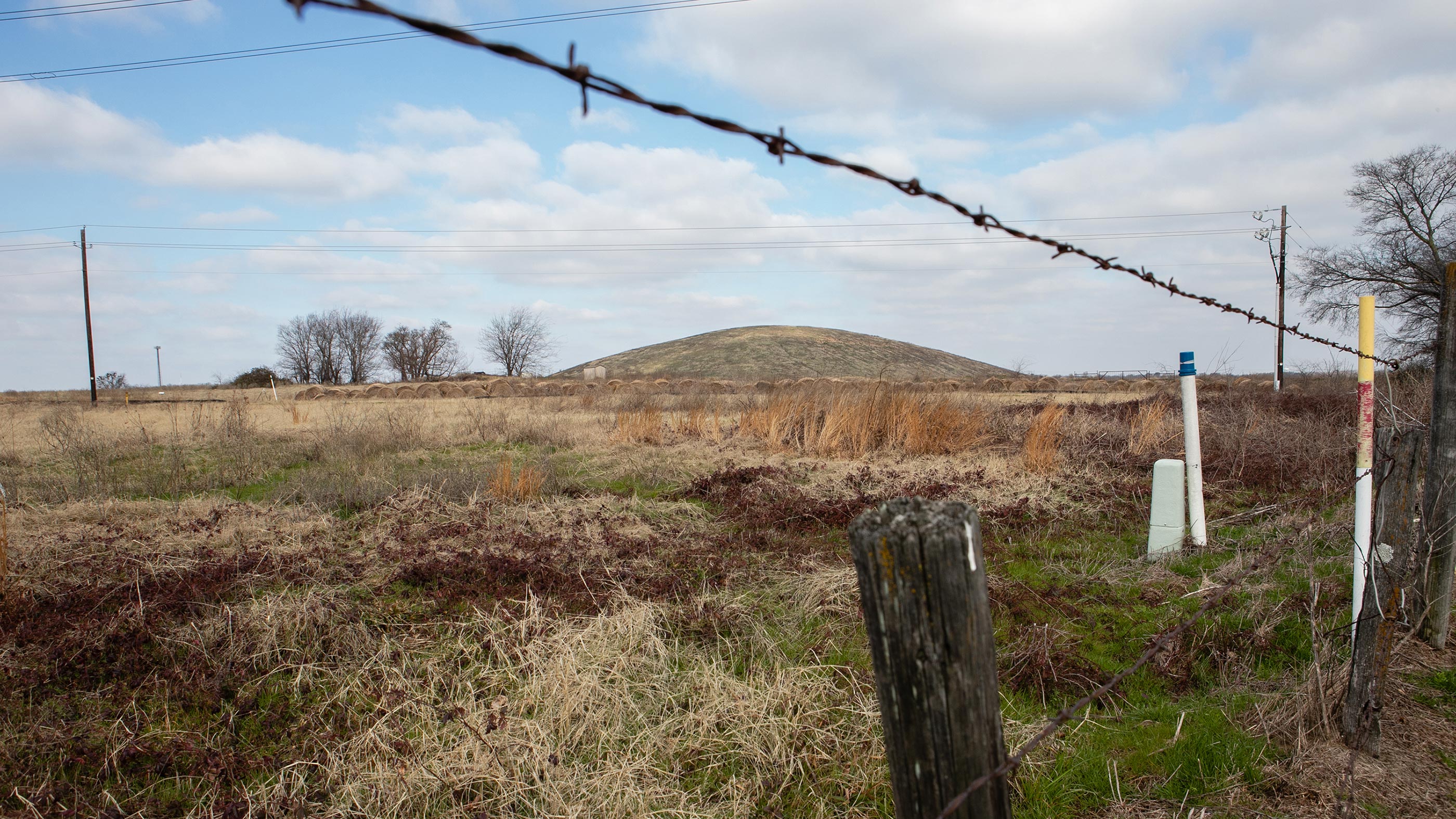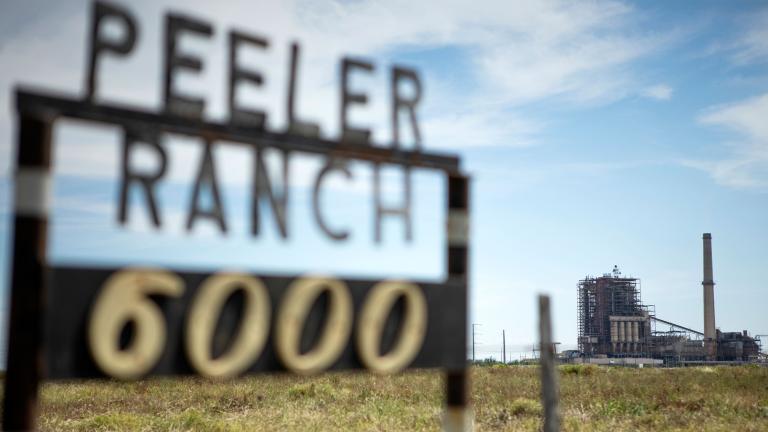This piece has been updated with a correction.
On a cold afternoon in January, Marc Maxwell strode across the historic town square in this East Texas town, pointing to all the new restaurants, bars, and boutiques on its periphery. Maxwell, a jovial public servant who has been Sulphur Springs’ city manager for more than two decades, explained how the city had turned tired streets into brick-paved roads that wrap around the main square, converted a parking lot into a proper plaza, and installed a row of electric car chargers near the police station.
“This used to be entirely shuttered up at night,” he said. “And now we’ve got 12 or 13 restaurants, a couple bars, and a brewery. You come out here tonight for dinner and it’s alive.”
As this once-sleepy whistlestop of 16,000 residents works to revitalize its downtown and economy, Maxwell is most excited about a project that hasn’t happened yet: the transformation of a recently shuttered coal mine into what town leaders envision as a recreational paradise.
A few years ago, as Irving-based Luminant, the largest electricity generator in Texas, prepared to close the decades-old Monticello Thermo mine on the southeast edge of town, Maxwell wondered what the company planned to do with its 4,900 acres.
In early 2017, after he had approached the company, his wildest dream came true: Luminant offered to give the land to the city for free. (Maxwell figures the tract could fetch as much as $25 million if the company sold it.)
“It’s a very significant and generous gift,” Maxwell said in an interview at the newly renovated city hall, where he described grand visions of transforming the land into a multifaceted park with jogging trails, fishing lakes, and maybe even space for hunting dog competitions. Such amenities, he said, would not only serve residents but draw tourists from miles away.
The community is pumped, too.
A 2017 poll conducted by KSST-AM, a local radio station, showed overwhelming support for outfitting the property with hike and bike trails — and a Target or Whole Foods.
“Everyone in Hopkins County is excited about the Thermo mine property,” said Adam Whitson, the station’s program director. “The city wants the property; the people want it.”
One major wrinkle is that — three years after shuttering the mine — Luminant is still working to restore the land. Decades-old state and federal laws require mining companies to “reclaim” land to its former condition after extracting coal so it can again be used for farming, grazing livestock, building homes — or as a city park.
The company has reclaimed about 80 percent of the former mine to the satisfaction of state regulators; it began that work just a year after it started mining there, in 1979. But it still has hundreds of acres to go. And the power-generating giant has been locked in a standoff with state regulators over its proposed restoration strategy, which — if the company gets its way — would allow it to leave toxic contaminants beneath a portion of Sulphur Springs’ future dream park.
The stalemate centers on a wide, 120-foot-tall heap of dirt that’s roughly the same volume as an Egyptian pyramid and a deep, sprawling mine pit at its base so acidic the rainwater accumulated in it can’t support plant life. Because of that, it’s an alluring blue-green color — like a Caribbean pool in the middle of rural Texas.
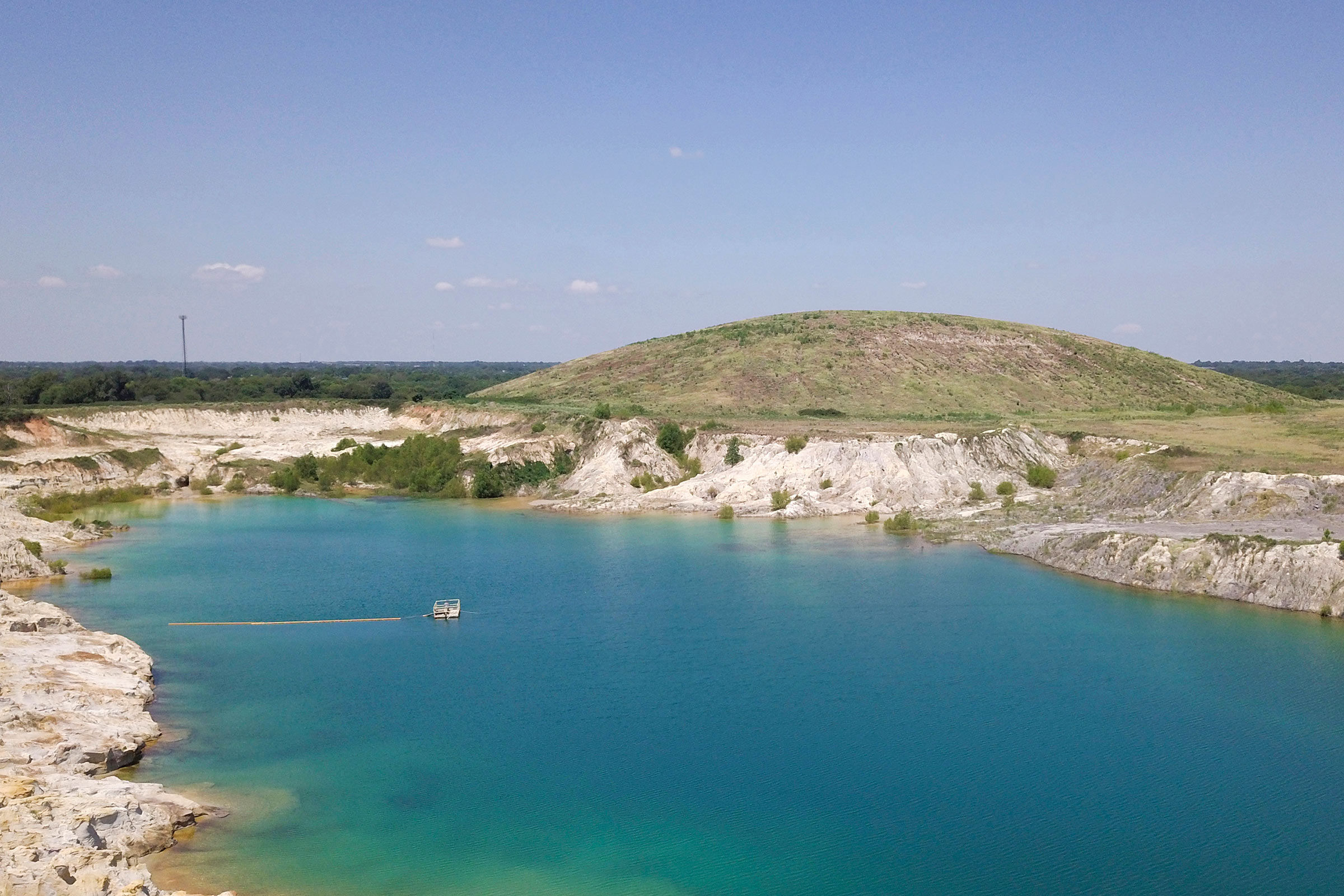
As the mine’s owner and former operator, Luminant, continues its cleanup of the site, it is gifting the land to the city of Sulphur Springs, which envisions turning the mound into an amphitheater and the pit into a fishing lake. The alluring color of the water in the pit is due to its high acidity. Miguel Gutierrez Jr. / The Texas Tribune
The Railroad Commission has found that the mound of excavated soil — which locals have nicknamed “Mount Thermo” — contains “acid and toxic forming materials,” substances that can turn into acidic or toxic materials when exposed to air and water. The agency’s tests of water sources near Mount Thermo found elevated levels of aluminum, which staff believe is leaching from the mound. But the company wants to leave the soil in place, arguing that it can cover it with a few feet of clean dirt to seal in the contaminants that have made the adjacent pit’s acidity spike.*
The city says it’s on board with that idea; Maxwell said he and other leaders envision building an amphitheater on the side of the mound and maybe turning the pit, which covers roughly 40 acres, into a fishing lake.
“We would very much like that [mound] to stay,” Maxwell said. “We’re in the frame of mind that we’d like it to have as steep of slopes as possible.”
But staff members in the Texas Railroad Commission’s Surface Mining and Reclamation Division, which oversees mine reclamation, have balked at Luminant’s proposal.
In a preliminary response to the proposed restoration plan, in which it laid out 21 concerns, agency staffers suggested that covering the mound with 4 feet of clean dirt violated a state regulation that says mining waste can’t be buried in areas where water drains because of the significant pollution risks it poses. Translation: Rain would simply wash away the new dirt, exposing the toxic materials again.
They also suggested the proposal violates what is one of the most basic tenets of coal mine reclamation: Longstanding state and federal rules require companies to return mined land to its former contours. In the prairieland of northeast Texas, that means gentle rolling hills.
Leaving such a large heap of excavated dirt in place is “unheard of,” said one former Railroad Commission staffer familiar with Luminant’s proposal. The staffer requested anonymity for fear that speaking to the press would lead to retaliation at their current workplace.
For more than two years, the company has gone back and forth with the reclamation division over the restoration plan. Not only has it pushed the division to approve it — mound, pit and, all — but agency documents show it has asked that it do so through an informal process that doesn’t require notifying the public.
In a written statement to Grist and The Texas Tribune, the company said that the city “asked for the mound to be left in place in order to eventually create an amphitheater” and added that the company can address the pond’s low pH “quite quickly” if its reclamation plan is approved. The deadline for residents to request a public hearing passed earlier this month.
Meanwhile, the city of Sulphur Springs is moving ahead with the development of the land. Online budget documents show it’s already sunk $157,000 into the property and plans to invest another $100,000 over the next year. Maxwell didn’t respond to follow-up questions about what the money will be spent on but has said that he expects Luminant to hand over the deed by the end of the year.
In the January interview at City Hall, he also dismissed concerns about the toxic materials in the mound, saying coal mining involved “just moving dirt.
“So what’s the risk?” he said.
Community asset or potential hazard?
Luminant came to town in the late 1970s to mine lignite, a low-grade type of coal, and purchased the rolling green pastureland in the small community of Thermo, a few miles outside Sulphur Springs. It scraped away grass, trees, and dirt and extracted the lignite for nearly four decades, shuttling it some 30 miles away to its Monticello Power Plant.
In 2011, Luminant announced it would shutter the Monticello Thermo mine, along with two others in lignite-rich northeast Texas, blaming new federal anti-pollution regulations it claimed would force it to use higher quality black coal from out of state. The company reversed course and operated for another five years, but then came a bigger threat: competition from cheap and abundant natural gas — a product of the recent shale revolution — as well as an ascendant renewable energy industry.
In 2014, its then-parent company, Dallas-based Energy Future Holdings, sought protection in one of the largest bankruptcy filings in U.S. history. Two years later, Luminant finally closed the Monticello Thermo mine, laying off 26 employees.
Now it’s doing everything it can to get out of the tanking coal business; in 2017, it announced it would close three of its six coal-fired power plants in Texas, including Monticello, and invest more in natural gas and renewables.
Today much of the former Thermo mine site looks like idyllic countryside again, blanketed in green grass and stands of fledgling pine trees. But a swath of land on the western side of the mine remains scarred, with bald, brown earth and mounds of orange-yellow sand.
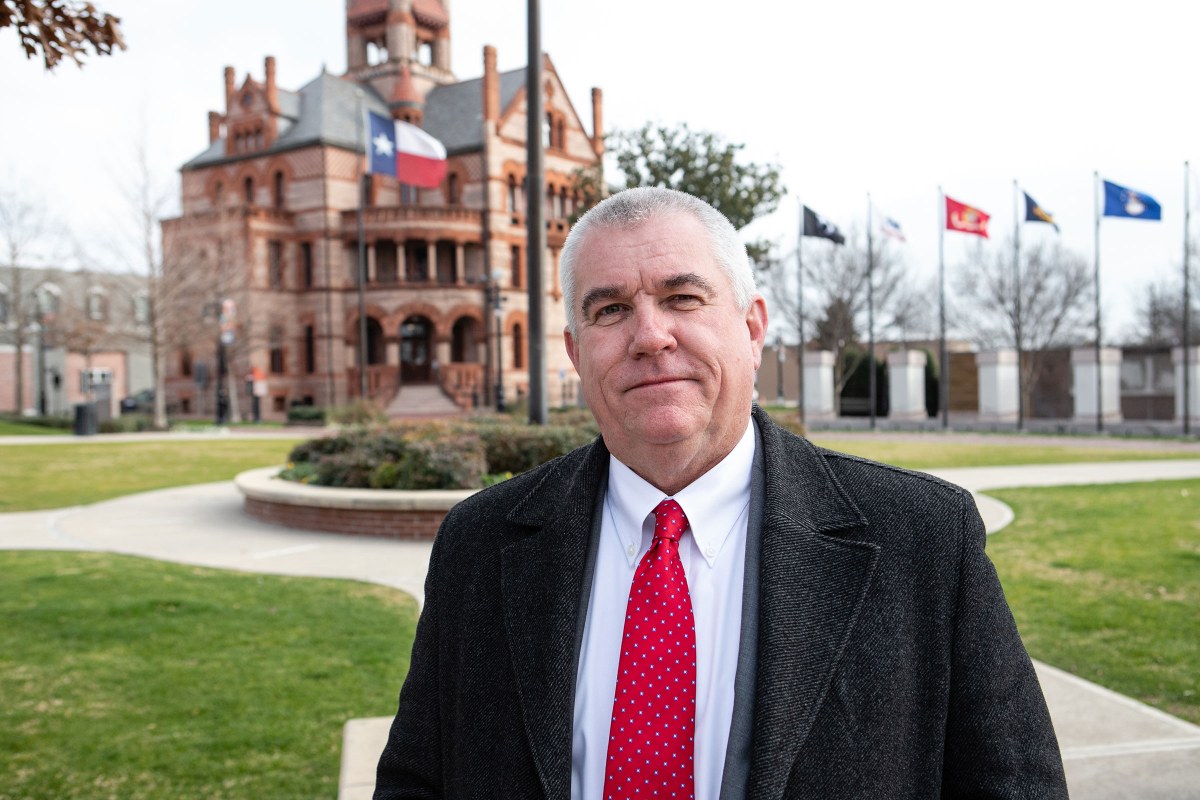
Marc Maxwell, the longtime city manager of Sulphur Springs, has led a sweeping revitalization effort in the northeast Texas town during his more than 20 years on the job. Leslie Boorhem-Stephenson / The Texas Tribune
The company still needs to reclaim the nearly 1,000 acres that surround the waste mound and the pit in that section. Early last year, the company sought a major alteration to its restoration strategy for hundreds of those acres: Instead of turning it back into pastureland like the rest of the property, Luminant said it wants to restore the land for use as an industrial or commercial site. While the designation dictates the level of reclamation, it doesn’t limit what the land can be used for.
Industrial-commercial, or I/C in industry speak, is a far lower reclamation standard that doesn’t require the companies to test the soil for contaminants. It also doesn’t require the state to monitor the land for years to ensure that grasses are growing properly.
For companies like Luminant, getting the state’s permission to use industrial-commercial standards is an easy way to save money on reclamation costs after a mine is played out.
Another former Railroad Commission staffer said the typical cost of reclaiming a cubic yard of soil is $1 to $2. Multiply that by 2 million cubic yards — which is the state’s estimated size of the waste mound at Luminant’s old mine — and the company could save as much as $4 million by leaving the mound in place.
The former staffers said that allowing Luminant to use industrial-commercial standards also would allow the company to wrap up reclamation work much faster — and get back almost $18 million in bond money held by the Railroad Commission. (Mining companies typically have to put up large bonds before they start operations as a guarantee that they will reclaim land after shuttering their mines.)
Ryan King, a biologist at Baylor University who has served as an expert witness in half a dozen federal lawsuits against coal companies, said staff concerns over the company’s reclamation plan are well founded.
“The idea of an amphitheater and having a lot of people right where you can potentially have a lot of airborne dust that is almost certainly going to contain toxic materials seems like a very risky situation,” he said. “That community is either uninformed or being misled about the potential hazards of doing such a thing.”
But Maxwell, the city manager, doesn’t see the problem. He said he trusts the Railroad Commission and Luminant will work it out, and that the company will do the right thing. “We don’t see a lot of risk there,” he said.
[protected-iframe id=”b70402374a407e38a98c3d9ee003c336-5104299-29763145″ info=”https://graphics.texastribune.org/graphics/reclamation-station-2019-08/monticello-thermo-satellite” width=”100%” height=”622″ frameborder=”0″]
The city is so trusting, in fact, that it didn’t conduct an environmental assessment of the land before inking an agreement with Luminant last fall that says the city will take ownership of the entire property, including the mound, the pit, roads, and other structures Luminant erected during the mining process. The City Council approved it unanimously.
The agreement says Luminant will have access to the land to continue reclamation work — for however long it takes. It also says Luminant is the only party that can terminate the agreement.
In text messages and emails obtained by Grist and the Tribune, Luminant appeared to coach Maxwell last year on what to tell the Railroad Commission as the company and the city advocated for the restoration plan that would leave the mound — which the company calls the “H-Area hill” — and pit in place.
“Marc, I believe the key message the RRC needs to hear tomorrow is your needs for the facilities, haulroads, [Farm to Market Road] 1870 overpass, the H-Area final pit lake and the H-Area Hill,” Luminant’s director of mine closure, Del McCabe, wrote in a May 2018 text to Maxwell. “I believe the H-Area Hill will bring up the most questions, but I would stress it will be used as the foundation for a future amphitheater and entertainment complex. Good luck tomorrow.”
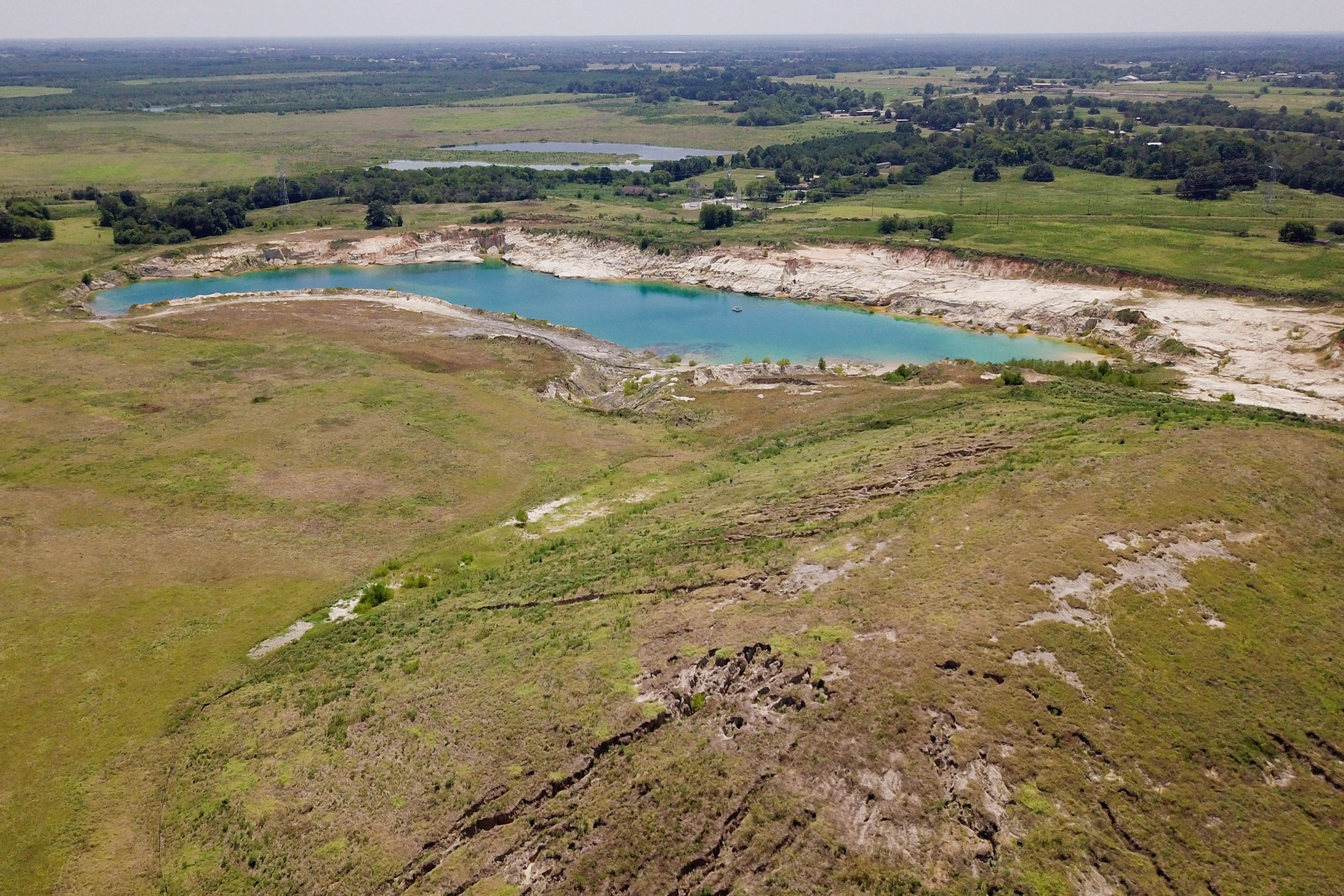
Leaving the mound of excavated dirt in place would save Luminant both time and money. A reclamation expert estimated it would cost as much as $4 million to remove it. Miguel Gutierrez Jr. / The Texas Tribune
In a prepared statement, Luminant spokesperson Meranda Cohn said that the company is committed to completing restoration of the property, including addressing the high acidity at the pit. She said the mound is being left in place at the city’s request and that any implication that Luminant’s deal with Sulphur Springs was solely a cost-saving measure was wrong.
“This transformative project would benefit the people of Sulphur Springs and East Texas for decades to come,” Cohn said. “This is a great example of how a public-private partnership between the city, Luminant, and the [Railroad Commission] can be a win for all.”
In 2017, the Texas Mining and Reclamation Association, of which Luminant is a member, honored Maxwell for his vision, granting him its “elected official of the year” award for “leading the charge to breathe new life into this community asset.”
A significant revision
In December 2017, five months after Luminant submitted its proposal for leaving the mound and pit in place, it got a response from the head of the Railroad Commission’s reclamation division, Denny Kingsley. He informed the company that its proposal would be considered a “significant revision” of its reclamation plan.
That designation would trigger a higher level of scrutiny, including review by an administrative law judge and the posting of a public notice of the company’s plans — unless Luminant could provide information proving the revision would not rise to the level of significant.
Luminant was furious.
In February 2018, the company sent a letter to Kingsley protesting his decision as “unjustified and unnecessary” and asking the division to reverse its decision.
Months later, in September, the division came back to Luminant saying that before the agency would make a final decision, the company would have to provide more information showing that the environmental impacts of its reclamation plan would be minimal.
Nearly a year later, the division and Luminant have yet to agree on a plan. In May, the company resubmitted the same proposal — without addressing the agency’s concerns — again emphasizing that Sulphur Springs had agreed to take the land in its present condition. But the commission’s general counsel, Alex Schoch, rejected it.
Luminant ultimately gave up in June, and the proposal is now being vetted by an administrative law judge at the commission.
The city of Sulphur Springs isn’t waiting on a final ruling from the state.
“Whether they’ve got a reclamation plan approved or not,” Maxwell said, “we’re moving ahead.”
*Correction: The original version of this piece incorrectly characterized the results of soil testing from the earthen mound known as Mount Thermo. The mound was found to contain “acid and toxic forming materials,” as well as elevated levels of aluminum.
This story is a collaboration between Grist and The Texas Tribune, a nonprofit, nonpartisan media organization that informs Texans — and engages with them — about public policy, politics, government, and statewide issues. Learn more at texastribune.org

